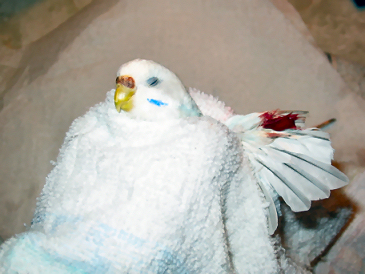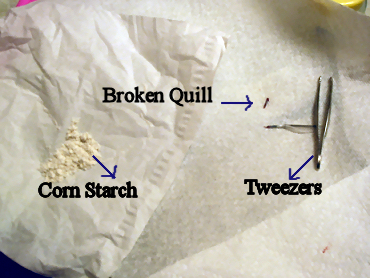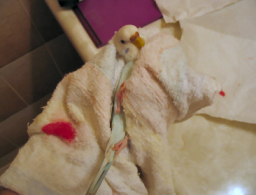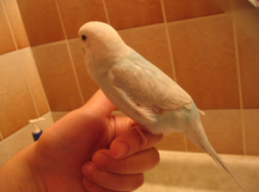Health & Nutrition
How To Deal With Blood Feather Breakage
What are blood feathers?
Blood feathers are new feathers that are just growing in. When feathers are emerging, they have a blood vessel in them to provide the materials needed to build the feather. Every growing feather is a blood feather, but small blood feathers usually don't cause any problems. The biggest potential problem involves the large feathers in the wing and tail. These feathers are more likely to be damaged while they're growing in than a small feather is, and they have a bigger blood vessel in them so excessive bleeding is likely to be a problem if these feathers get damaged.
Blood feathers have a keratin sheath around them which helps protect the growing feather and the blood vessel from damage. This sheath is basically a tube that looks sort of like the end of a shoe lace. It looks waxy and tight, and it's dark or reddish because of the blood supply inside it.
When the feather matures, the blood vessel withers away. The feather no longer has a blood supply flowing into it, and cutting or breaking the shaft of the feather will not cause bleeding. There can still be bleeding if a mature feather is knocked loose, but this is caused by damage to the blood vessels in the skin. The blood is coming from the skin, not from the feather itself. Blood clots form much more easily in the skin than they do in the shaft of a broken blood feather, so you usually won't need to do anything but keep the bird calm and wait for the bleeding to stop. If there is a large wound to the flesh of the wing, you will need to take care of it the same way you would with any other flesh wound.
How do blood feathers break?
The most common place for broken blood feathers is the flight feathers on the wing. Blood feathers can be damaged if they are not noticed when the bird is being clipped, so always watch out for them during clipping and never cut through the keratin sheath of a blood feather. Blood feathers can also be damaged by accidents like falls, crash impacts, and night frights. Genetic disorders and pre-existing health conditions can make blood feathers more fragile and more likely to be broken.
How to Handle A Blood Feather Breakage
When your bird has broken a blood feather, you must act quickly and efficiently to minimize the blood loss. The number one rule is to remain calm and work quickly. You may want to contact your vet if you think you can get hold of them quickly. But time is of the essence if the feather is bleeding heavily, and you may not have time to take the bird to the vet. Pulling blood feathers isn't difficult if you have the proper equipment and can do a reasonably effective job of restraining the bird.
Equipment you will need:
- Clean Towel
- Small pliers or tweezers. Pliers are best.
- Corn starch or flour
- An electrolyte solution (to help cope with the blood loss if the bird has lost a significant amount of blood).
- A magnifying glass to examine the area of wound
It is highly recommended that you keep a first aid kit handy. These items should be kept in this kit so that when emergencies occur, you won't have to scramble all over the place to pull together the required equipment and materials. Click here for the recommended items to include in a first aid kit.

Step One: Restrain the injured bird with a clean towel in a well lit place. This will be easiest if you have another person available to help you, but one person can manage a small bird by themselves. It is helpful to position the towel so the bird can bite it instead of trying to bite you.
Hold the bird securely but not too tightly. Birds do not have a diaphragm, and must be able to move their chest up and down in order to breathe. Try to prevent struggling, because exertion makes the heart beat faster and will cause more bleeding.
Gently stretch out the injured wing and hold it securely in place.

Step Two: Look closely at the injured area (using a magnifying glass if necessary) to identify the broken blood feather. If the main part of the feather has broken off completely, there may be nothing left but a small stub of the quill. If there is too much blood in the area, gently clean it away so you can see the feathers more clearly. Once you have identified the correct feather, grasp the quill with the pliers or tweezers as close to the skin as you can. Pull it out with a firm, swift motion in the same direction that the feather normally grows; do not pull it at an angle that will make the quill twist in the skin. When the quill is out, apply corn starch or flour to the wound to help the blood clot. Do NOT use styptic powder on Kwik Stop on the wound; they are fine for bleeding nails (which is another example of blood flowing through a keratin tube). But these products can cause chemical burns on living tissue like skin.
Damaged blood feathers are dangerous even if the bleeding has already stopped. It's very easy for the bleeding to start up again when the bird preens the area or if the damaged feather gets bumped. So once a blood feather has been damaged it's safest to remove it rather than leaving it in and hoping that nothing else bad will happen.

Step Three: Apply gentle pressure on the wound until you are fairly certain that the bleeding has stopped. You still want to prevent the bird from struggling if you can. Being restrained like this is stressful for the bird, so release the bird as soon as you can so it can calm down and cool off. Try to keep the bird quiet and calm for a few hours to reduce the risk of reopening the wound. It will be best to put the bird in a small cage where he feels comfortable and can reach the food and water easily.
What to do for major blood loss
If the bird has lost a lot of blood, it's desirable to call your vet and ask for advice. But once the bleeding has stopped there may not be anything else they can do, and the bird will be less stressed at home.
If the bird is weak, it's desirable to give him an electrolyte solution to rehydrate him and replace lost ions. Sports drinks, coconut water, or Pedialyte will serve the purpose. There are also simple recipes available for homemade electrolyte solutions, like this one on WebMD. Electrolyte solutions will usually make a weak bird start acting more energetic a few minutes after he drinks it. Keep on providing the electrolyte solution until you feel that the bird is maintaining a reasonably good energy level.
It's also desirable to also provide some supplemental heat. You can put a heating pad under half the cage (be aware that most modern heating pads shut off automatically after a while). Or you can put a towel across one end of the cage and shine a lamp on it so that the heat goes into the cage, but not so close that it could set the towel on fire. You need an old-fashioned incandescent light bulb for this, because they generate heat and LED bulbs don't. The reason you only heat half the cage is so the bird can move to the unheated side if he gets too warm. You can turn off the heat when the bird starts moving around the cage in a reasonably energetic way instead of huddling on the warm side.
If the bird seems too weak to want to feed himself, you can hold food in your hand for him to eat. If he's not drinking the electrolyte solution, you can soak some seeds in the electrolyte solution and feed them to him off your fingertip. Birds can regenerate lost blood cells faster than humans can, so it may take only a couple of days for him to start acting more normal.

The bird will probably have bloodstained feathers afterward. But don't encourage the bird to take a bath and don't try to wash the bloodstains off the feathers yourself. Wounds reopen more easily when they are wet, and you need to keep it dry so the wound can heal. The bloodstains may be distressing to you but they don't bother the bird, and his wellbeing is what matters. Most of the dried blood will flake off within a couple of days. There may be a small amount of permanent staining, but this will disappear when the bird molts the old feathers.

